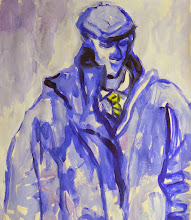While I can convince myself that my 'subconscious musings' are a valid way of generating absract images I was beginning to feel that something was lacking in them - they were becoming too formal and formulistic? They were, to my mind, good images but I began to think that while the initial "doodle" was produced from my subconscious it was what I did with it later that was troubling me. I had begun to impose considered design and thought onto them. Now, even though I carried out that part of the process as spontaneously as I could, I knew choices were being made - shape definition, colour, texture - which were all fully conscious (well as much as I can muster at the best of times!).
Before I rushed off into my studio to fling paint up the walls, I chose to do some research first, starting with someone I believed worked directly from his subconscious: Franz Kline.
What I found, however, was quite different from what I thought. It turns out that Kline had been engaged in exactly the same process as I have been describing, above. He also started his picture-making by creating bold, so called "spontaneous", designs from his subconscious using black ink or paint on the pages of old telephone directories. Most of these are very graphic, but apparently he then developed them into small studies (as I have been doing) and then
very carefully recreated his designs as full-sized paintings while maintaining their apparent spontaneity. Can this still be considered "pure" abstract?
Shaking off that thought, and with a determination to get right down to the nitty-gritty of creating abstracts without any design development, I went out to my studio.
What transpired was an extended afternoon session where I painted six-in-a-row using acrylics, four on paper and two on cardboard:
 Abstract #9
Abstract #9, acrylics on paper, 26.5x35cm.
#10 is missing here because I think I was trying too hard and it just looked a mess.
 Abstract #11
Abstract #11, acrylics on paper, 23x25.5cm.
 Abstract #12
Abstract #12, acrylics on paper, 27x36cm.
 Abstract #13
Abstract #13, acrylics on board, 40x30cm.
 Abstract #14
Abstract #14, acrylics on board, 40x30cm.
A very pleasing and satisfactory afternoon's work. I stopped exhausted but happy that I had actually been able to create paintings in this way.
The question is: Can I do it again?
We shall see.















